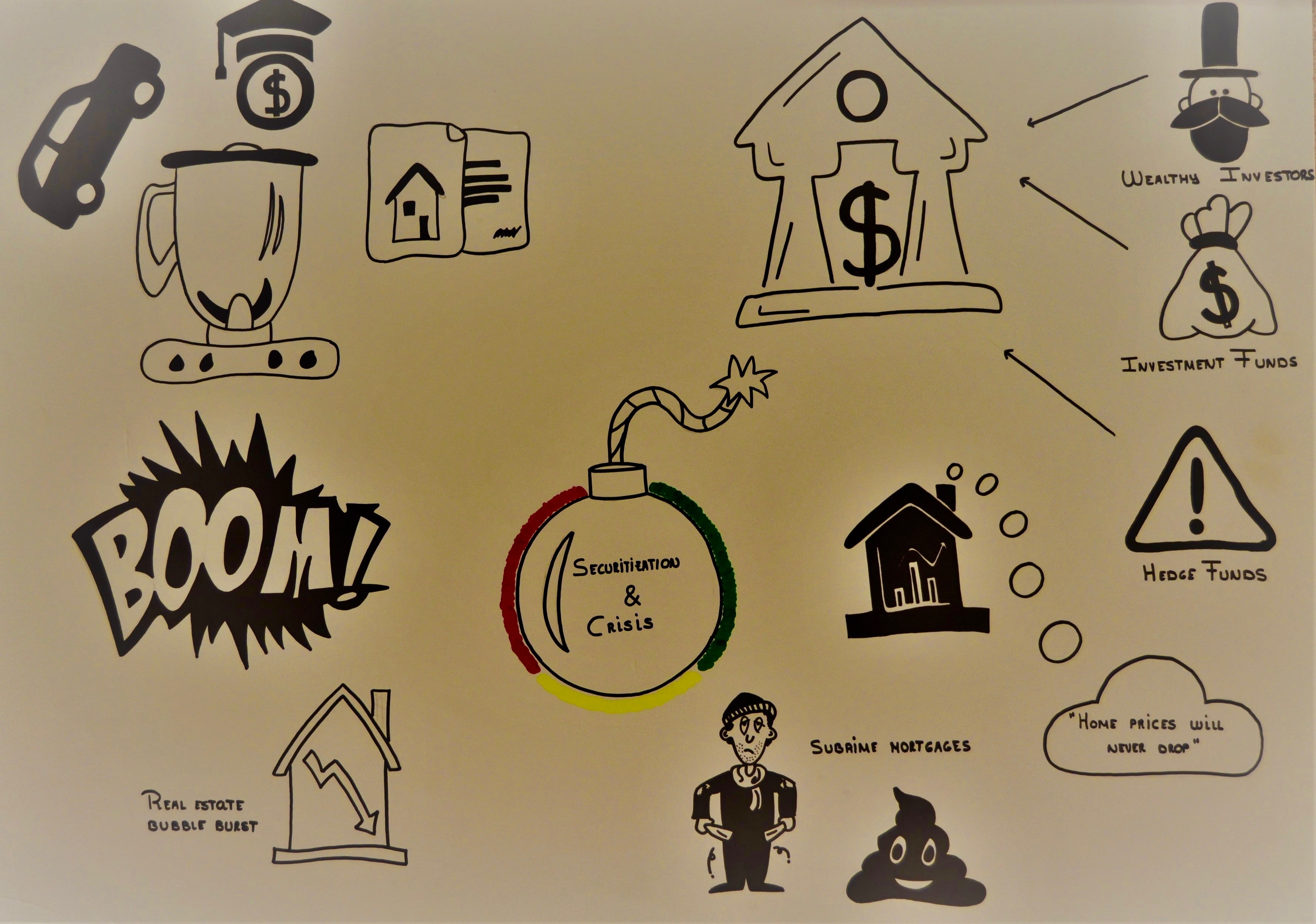
Securitization is a procedure whereby a financial institution creates a package of different assets, such as loans and credits, and then sells it. Thanks to this operation the issuer receives immediate cash and reduces the risk of its business by transmitting part of it to the investor. The buyer receives a profit in form of regular payments throughout the life of the instrument and also the amount lent at the end.
Securitization instruments played a vital role as one of the triggers of the 2008 financial crisis due to its importance in the credit crisis that affected the United States financial system. During the early 2000s, investment banks increased the commercialization of securitization titles backed with mortgage loans such as MBSs and CDOs. There was a huge demand boosted by low-interest rate conditions and the illusion that the real estate market was solid rock. Then banks started to bundle high-risk mortgages, also known as subprime, into those assets. As debtors began to fail their payments after the real estate bubble burst, and investors realized that the titles were full of toxic mortgages, the market for those products deteriorated and some specialized institutions went bankrupt. The bottom line was the loss of trust among market’s agents and the subsequent credit crisis that later passed on to other economies and ended up, after several mutations, being a central cause of the 2008 financial crisis.

Профессиональный сервисный центр по ремонту бытовой техники с выездом на дом.
Мы предлагаем:сервис центры бытовой техники москва
Наши мастера оперативно устранят неисправности вашего устройства в сервисе или с выездом на дом!
Профессиональный сервисный центр по ремонту бытовой техники с выездом на дом.
Мы предлагаем:сервис центры бытовой техники москва
Наши мастера оперативно устранят неисправности вашего устройства в сервисе или с выездом на дом!
equilibrado estatico
Aparatos de calibracion: fundamental para el rendimiento uniforme y optimo de las equipos.
En el entorno de la avances contemporanea, donde la eficiencia y la confiabilidad del aparato son de gran relevancia, los equipos de ajuste tienen un rol crucial. Estos dispositivos especificos estan desarrollados para balancear y fijar piezas giratorias, ya sea en dispositivos industrial, automoviles de traslado o incluso en dispositivos domesticos.
Para los tecnicos en conservacion de sistemas y los ingenieros, trabajar con dispositivos de equilibrado es crucial para proteger el desempeno estable y seguro de cualquier mecanismo giratorio. Gracias a estas soluciones innovadoras sofisticadas, es posible disminuir considerablemente las movimientos, el sonido y la presion sobre los rodamientos, mejorando la longevidad de elementos caros.
Tambien importante es el rol que tienen los equipos de balanceo en la atencion al cliente. El apoyo tecnico y el conservacion regular aplicando estos equipos permiten ofrecer asistencias de optima excelencia, elevando la contento de los clientes.
Para los propietarios de empresas, la contribucion en sistemas de ajuste y dispositivos puede ser fundamental para mejorar la productividad y productividad de sus aparatos. Esto es particularmente significativo para los emprendedores que dirigen reducidas y modestas emprendimientos, donde cada detalle importa.
Ademas, los equipos de equilibrado tienen una vasta implementacion en el area de la fiabilidad y el gestion de calidad. Posibilitan localizar eventuales errores, previniendo mantenimientos onerosas y problemas a los dispositivos. Incluso, los resultados generados de estos aparatos pueden emplearse para optimizar procedimientos y potenciar la visibilidad en sistemas de busqueda.
Las areas de uso de los equipos de ajuste abarcan numerosas sectores, desde la fabricacion de bicicletas hasta el seguimiento ambiental. No afecta si se refiere de enormes elaboraciones productivas o pequenos locales hogarenos, los equipos de calibracion son esenciales para asegurar un rendimiento efectivo y sin interrupciones.
https://medium.com/@nsw5288/%EB%B9%84%EC%95%84%EA%B7%B8%EB%9D%BC-%ED%8C%8C%EB%8A%94%EA%B3%B3-b91273007f40
https://ko.anotepad.com/note/read/h5kk7d4j
https://zippy-tomato-dbgzhv.mystrikingly.com/blog/b0c4e583f8a
https://xn--fv-hd0jg6f81ltjas9lbns.mystrikingly.com/blog/5361e2c2891
https://viastoer.blogspot.com/2024/10/5.html
https://medium.com/@nsw5288/%EB%B0%9C%EA%B8%B0%EB%B6%80%EC%A0%84%EA%B3%BC-%EC%A1%B0%EB%A3%A8-%EC%89%BD%EA%B2%8C-%EC%9D%B4%ED%95%B4%ED%95%98%EA%B3%A0-%EA%B7%B9%EB%B3%B5%ED%95%98%EB%8A%94-%EB%B2%95-5212fd7c4fa0
https://hardworking-owl-dc4vlt.mystrikingly.com/blog/5006b8c3495
https://viastoer.blogspot.com/2024/09/blog-post_61.html
https://tawny-wombat-dd3cmn.mystrikingly.com/blog/4cd329160f9
https://ko.anotepad.com/note/read/s7rk2rnw
https://xn--fn-hd0jg6f81ltjas9lbns.mystrikingly.com/blog/290000a8b29
https://grape-pear-dbgzh0.mystrikingly.com/blog/168b2fbf9d5
https://hukukevi.net/user/naveridbuy
https://medium.com/@nsw5288/%EB%B9%84%EC%95%84%EA%B7%B8%EB%9D%BC-%EA%B0%99%EC%9D%B4-%EB%A8%B9%EC%9C%BC%EB%A9%B4-%EC%95%88%EB%90%98%EB%8A%94-%EC%95%BD-e6a7bb6e99ff
https://ko.anotepad.com/note/read/4sx68hne
https://ameblo.jp/naveridbuy/entry-12866333257.html
https://telegra.ph/%EB%B9%84%EC%95%84%EA%B7%B8%EB%9D%BC-%EA%B5%AC%EB%A7%A4-%EC%8B%9C-%EA%B3%A0%EB%A0%A4%ED%95%B4%EC%95%BC-%ED%95%A0-%EA%B0%9C%EC%9D%B8%EC%A0%81%EC%9D%B8-%EA%B1%B4%EA%B0%95-%EC%9A%94%EC%86%8C-07-31
https://telegra.ph/%EB%B9%84%EC%95%84%EA%B7%B8%EB%9D%BC-%EA%B5%AC%EB%A7%A4%EC%9D%98-%EB%B2%95%EC%A0%81-%EC%82%AC%ED%95%AD%EA%B3%BC-%EA%B7%9C%EC%A0%95-07-31
https://optimistic-wombat-dc4vlt.mystrikingly.com/blog/45d92633d63
https://golden-grape-dd3cml.mystrikingly.com/blog/4644761650e
https://energetic-goat-dc4vlq.mystrikingly.com/blog/1b973c46327
https://turquoise-dove-dd3cmd.mystrikingly.com/blog/c93bf9514ff
https://responsible-seal-dd3cm4.mystrikingly.com/blog/268981e831e
https://viastoer.blogspot.com/2024/09/blog-post_80.html
https://gajweor.pixnet.net/blog/post/162316945
https://medium.com/@nsw5288/%EB%B9%84%EC%95%84%EA%B7%B8%EB%9D%BC-%EA%B5%AC%EB%A7%A4%EC%99%80-%EA%B4%80%EB%A0%A8%EB%90%9C-%EC%A3%BC%EC%9A%94-%EC%A7%88%EB%AC%B8%EA%B3%BC-%EB%8B%B5%EB%B3%80-552ce203761b
https://medium.com/@dqvchristopherwhite824/%EB%84%A4%EC%9D%B4%EB%B2%84-%EC%95%84%EC%9D%B4%EB%94%94-%EA%B5%AC%EB%A7%A4%EB%A1%9C-%EC%9D%B8%ED%95%9C-%EA%B3%84%EC%A0%95-%EC%B0%A8%EB%8B%A8-%EB%B0%8F-%EC%A0%9C%EC%9E%AC-%EC%9C%84%ED%97%98-af16476b0122
https://medium.com/@nsw5288/%EB%B9%84%EC%95%84%EA%B7%B8%EB%9D%BC-%EC%82%AC%EC%9A%A9%EB%B2%95%EA%B3%BC-%EB%B6%80%EC%9E%91%EC%9A%A9%EC%9D%80-916393446295
https://viastoer.blogspot.com/2024/09/blog-post.html
https://medium.com/@nsw5288/%EB%B9%84%EC%95%84%EA%B7%B8%EB%9D%BC-%EC%98%A8%EB%9D%BC%EC%9D%B8-%EA%B5%AC%EB%A7%A4-%EB%B0%A9%EB%B2%95%EA%B3%BC-%EC%A3%BC%EC%9D%98-%EC%82%AC%ED%95%AD-c80ca72b0103
https://xn--fm-hd0jg6f81ltjas9lbns.mystrikingly.com/blog/vs
https://dun-swam-dbgzhz.mystrikingly.com/blog/395b5452bec
https://ko.anotepad.com/note/read/pymsgn44
https://xn--he-hd0j99gyns5zflam0o3rd.mystrikingly.com/blog/208c9364399
https://medium.com/@carlfrancoh38793/%EB%84%A4%EC%9D%B4%EB%B2%84-%EC%95%84%EC%9D%B4%EB%94%94-%EA%B5%AC%EB%A7%A4-%EC%A0%84-%EC%95%8C%EC%95%84%EC%95%BC-%ED%95%A0-%ED%95%84%EC%88%98-%EC%A0%95%EB%B3%B4-31cf4c7582d4
https://bronze-antelope-dc4vld.mystrikingly.com/blog/214a9fbbd05
https://ko.anotepad.com/note/read/h5kk7d4j
https://vermilion-elephant-dd3cm3.mystrikingly.com/blog/vs
https://ameblo.jp/naveridbuy/entry-12866333534.html
https://telegra.ph/%EB%B9%84%EC%95%84%EA%B7%B8%EB%9D%BC-%EC%98%A8%EB%9D%BC%EC%9D%B8-%EA%B5%AC%EB%A7%A4-%ED%9B%84%EA%B8%B0%EC%99%80-%EC%A3%BC%EC%9D%98%ED%95%B4%EC%95%BC-%ED%95%A0-%EC%A0%90%EB%93%A4-09-20
https://indigo-magnolia-dc4vl0.mystrikingly.com/blog/c1db5c61362
https://shenasname.ir/ask/user/IDmall+-+%EC%95%84%EC%9D%B4%EB%94%94%EB%AA%B0
https://3dwarehouse.sketchup.com/by/naverid
https://patient-onion-dc4vlp.mystrikingly.com/blog/f75b9082a23
https://medium.com/@1kelly76/%EB%82%A8%EC%84%B1-%EA%B1%B4%EA%B0%95%EC%9D%98-%EC%A0%81%EC%8B%A0%ED%98%B8-%EB%B0%9C%EA%B8%B0%EB%B6%80%EC%A0%84%EA%B3%BC-%EC%A1%B0%EB%A3%A8-%EA%B7%B9%EB%B3%B5%ED%95%98%EA%B8%B0-79599575ec8b
https://peaceful-raccoon-dbgzh6.mystrikingly.com/blog/vs
https://writeablog.net/7ez5ljw06r
https://hallbook.com.br/blogs/313105/%EB%B9%84%EC%95%84%EA%B7%B8%EB%9D%BC-%EC%A0%9C%EB%84%A4%EB%A6%AD-%EC%A0%9C%ED%92%88-%EA%B0%80%EA%B2%A9%EA%B3%BC-%ED%9A%A8%EA%B3%BC-%EB%B9%84%EA%B5%90
https://medium.com/@dqvchristopherwhite824/%EA%B5%AC%EA%B8%80-seo-%EC%B5%9C%EC%A0%81%ED%99%94%EB%A1%9C-%EA%B2%80%EC%83%89-%EC%83%81%EC%9C%84-%EB%85%B8%EC%B6%9C%EB%90%98%EB%8A%94-%EB%B0%A9%EB%B2%95-b43a859d222c
https://xn--fz-hd0jg6f81ltjas9lbns.mystrikingly.com/blog/64c3eab6211
https://candid-dinosaur-dbgzhv.mystrikingly.com/blog/5
https://writeablog.net/vh97m08dqv
https://vermilion-elephant-dd3cm3.mystrikingly.com/blog/81c036fe194
https://naveridbuy.exblog.jp/35859445/